Are you wondering, “Can I Buy Pottery Directly From The Artisans In Phu Lang?” Absolutely! Phu Lang Pottery Village, near Hanoi, Vietnam, offers a unique opportunity to purchase authentic pottery directly from the craftsmen. SIXT.VN can help you plan your trip to this traditional village and experience the beauty of Vietnamese culture. Explore traditional crafts and create lasting memories.
1. Discovering Phu Lang Pottery Village
Phu Lang Pottery Village, located about 60 kilometers east of Hanoi, provides a captivating journey into a world where time seems to stand still. This picturesque village, nestled along the banks of the Cau River, has been a center for pottery making since the 13th century. According to historical records and local accounts, the craft has been passed down through generations, maintaining its authenticity and charm.
 Phu Lang Pottery Village Overview
Phu Lang Pottery Village Overview
1.1. What Makes Phu Lang Pottery Unique?
Phu Lang pottery is renowned for its distinctive light brown glaze, setting it apart from other pottery centers like Bat Trang and Tho Ha. The primary products include cooking pots, tiles, jars, and burial caskets, all crafted with traditional techniques.
1.2. Why Visit Phu Lang Over Other Pottery Villages?
While Bat Trang is more famous, Phu Lang offers a less touristy and more authentic experience. The village’s charm lies in its small houses built with clay bricks and surrounded by stacks of pottery, creating a harmonious blend with the peaceful countryside.
1.3. How Are Traditional Kilns Used?
The villagers still use traditional wood-fired kilns, large enough to walk inside when not in use. These kilns contribute to the unique character of Phu Lang pottery.
2. Meeting the Artisans of Phu Lang
Visiting Phu Lang offers a chance to connect with local artisans who are passionate about preserving their heritage. Many families have been involved in pottery making for generations, and their workshops serve as both production sites and showrooms.
2.1. Can I Interact With the Artisans?
Yes, you are welcome to stop by and talk to the artisans. They are eager to share their knowledge and demonstrate their skills.
2.2. What Can I Learn From Them?
You can learn about the traditional techniques and the history of pottery making in Phu Lang.
2.3. How Do the Artisans Maintain Their Craft?
The artisans are committed to reviving the fame of Phu Lang pottery through dedication and hard work.
3. The Significance of Burial Caskets in Phu Lang
An intriguing aspect of Phu Lang is the presence of burial caskets, often seen along the roadsides. These caskets play a vital role in Vietnamese funeral traditions.
3.1. What Is the Purpose of These Caskets?
In Vietnamese culture, after a burial period of 3-4 years, the family exhumes the remains, cleans the bones, and places them in these small coffins.
3.2. Why Are There Holes in the Caskets?
The holes on the side of the coffin are believed to allow the spirit to move freely.
3.3. What Happens After the Remains Are Placed in the Casket?
The burial caskets are reburied in a new location chosen according to Feng Shui principles, believed to bring wealth and prosperity to the family.
4. Planning Your Visit to Phu Lang with SIXT.VN
SIXT.VN offers comprehensive travel services to make your visit to Phu Lang seamless and enjoyable. From transportation to accommodation, SIXT.VN ensures a hassle-free experience.
4.1. How Can SIXT.VN Help Me Get to Phu Lang?
SIXT.VN provides reliable transportation options, including private car services, to take you from Hanoi to Phu Lang.
4.2. What Other Services Does SIXT.VN Offer?
SIXT.VN can assist with booking accommodations, arranging tours, and providing local guides to enhance your visit.
4.3. Why Choose SIXT.VN for My Trip?
SIXT.VN offers convenient, reliable, and high-quality services tailored to your travel needs, ensuring a memorable experience.
5. Exploring Hanoi’s Craft Villages: A Cultural Journey
Hanoi and its surrounding areas are rich in traditional craft villages, each specializing in a unique art form. Exploring these villages offers a deep dive into Vietnamese culture and heritage.
5.1. What Makes Hanoi and Its Surroundings Special?
Hanoi and its nearby villages have a long history of producing exquisite craft products. Craftsmen and tradesmen from these areas established shops around the Old Quarter, showcasing their skills.
5.2. How Are These Crafts Integrated Into Daily Life?
These crafts are integral to daily life, with families participating in the production process. Visiting these villages provides insight into how these ancient skills have been preserved through generations.
5.3. What Can I Expect to See in These Villages?
You can witness the production of various crafts, learn about the artisans’ techniques, and appreciate the cultural significance of their work.
6. A Day Tour of Hanoi’s Craft Villages
Many of Hanoi’s craft villages can be visited in a day tour, offering a glimpse into the diverse artistic traditions of the region.
6.1. Which Villages Can I Visit in a Day?
Villages like Kieu Ky (gold beating) and Canh Hoach (bird cage making) are easily accessible for a day trip.
6.2. What Are the Traditional Products of These Villages?
These villages produce a range of items, from gold leaves to intricate bird cages, all of which are still used in everyday life.
6.3. How Can I Arrange a Day Tour?
SIXT.VN offers organized day tours to these craft villages, providing transportation, guides, and a curated itinerary.
7. Quang Phu Cau Incense Village: Aromatic Traditions
Located about 40 kilometers from Hanoi, Quang Phu Cau Incense Village is renowned for its colorful craft, which has been practiced for over a century.
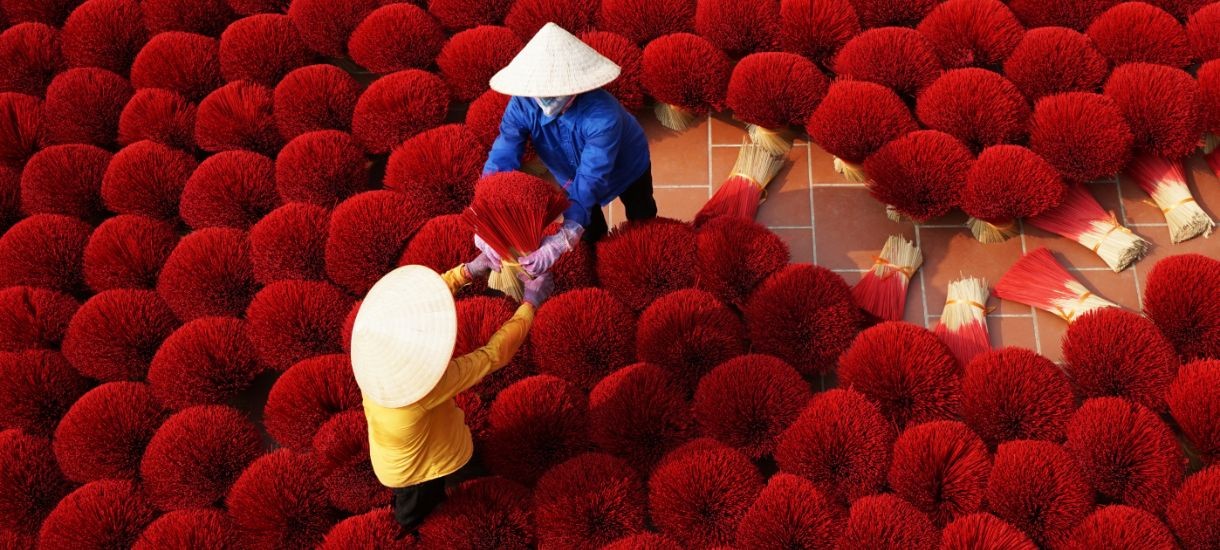 Quang Phu Cau Incense Village
Quang Phu Cau Incense Village
7.1. What Is the Significance of Incense in Vietnamese Culture?
Incense plays a crucial role in Vietnamese beliefs, serving as a means of communication with the deceased.
7.2. How Is Incense Made in Quang Phu Cau?
The production process involves multiple steps, from chopping bamboo to dyeing the incense roots red and adding incense paste.
7.3. Why Is This Village So Picturesque?
The village is known for its stunning visuals, with bunches of incense sticks spread out to dry, creating a sea of vibrant red hues.
8. Xuan Lai Burnt Bamboo Furniture: Unique Designs
Xuan Lai is famous for its burnt bamboo furniture, distinguished by its dark brown color and unique designs. This craft has been practiced for at least 150 years.
8.1. What Makes Xuan Lai Bamboo Furniture Special?
The distinctive dark brown color is achieved through a special scorching process, requiring time and skill.
8.2. How Is the Bamboo Prepared?
The bamboo is soaked for months, cleaned, and then scorched in kilns using decomposed straw as fuel.
8.3. What Products Are Made From Burnt Bamboo?
Artisans create a variety of items, including beds, benches, tables, lamps, and decorative bamboo pictures.
9. Thu Sy Bamboo Fish Trap Village: Ancient Techniques
Thu Sy, located 60 kilometers from Hanoi, is an authentic northern village known for its bamboo fish traps.
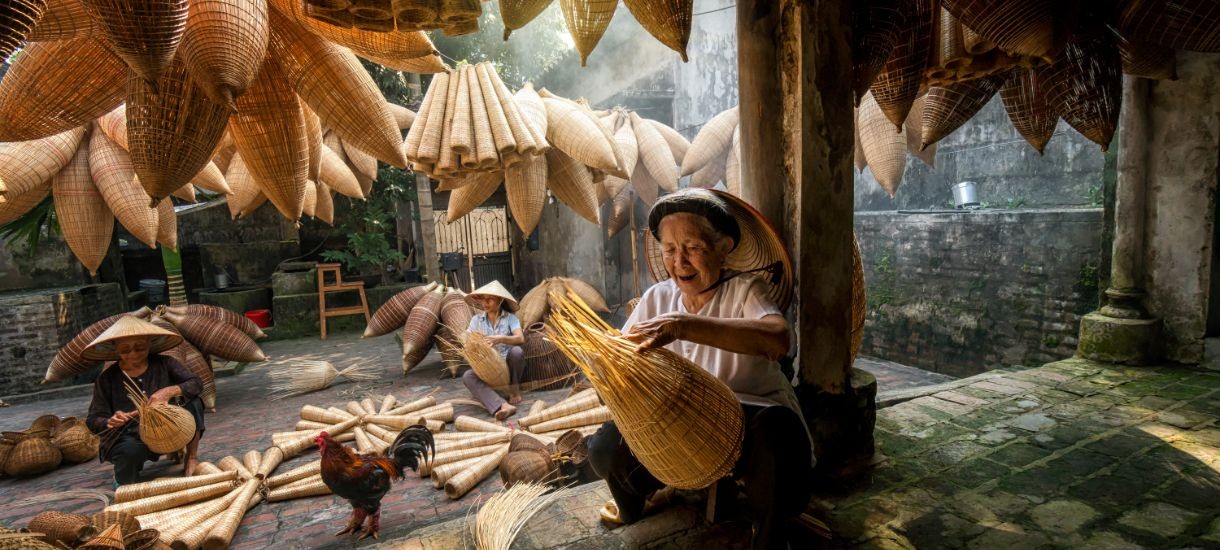 Thu Sy Bamboo Fish Trap Village
Thu Sy Bamboo Fish Trap Village
9.1. How Long Has This Craft Been Practiced?
The tradition of making bamboo fish traps in Thu Sy dates back over two centuries.
9.2. What Skills Are Required to Make These Traps?
Craftsmen use their hands and chins to split raw bamboo into thin strips before knitting them together.
9.3. How Are the Fish Traps Finished?
The fish traps undergo a scorching process similar to that used in Xuan Lai, giving them a golden-brown color.
10. Bat Trang Ceramic Village: A Popular Destination
Bat Trang, situated 15 kilometers from Hanoi, is the most visited craft village in Vietnam, renowned for its ceramic products.
10.1. How Does Bat Trang Differ From Phu Lang?
Bat Trang is more touristy and diverse in its product offerings, with a larger number of busy workshops.
10.2. What Modern Techniques Are Used in Bat Trang?
Smart gas kilns are replacing traditional charcoal-fired kilns, and potters use modern molding techniques.
10.3. Can Visitors Try Their Hand at Pottery?
Yes, some workshops offer visitors the opportunity to try making pottery on non-motorized wheels.
11. Kieu Ky Gold Beating: A Rare Art
Kieu Ky is the only village in Vietnam that specializes in making gold and silver leaves through gold beating, a craft that has existed for nearly 300 years.
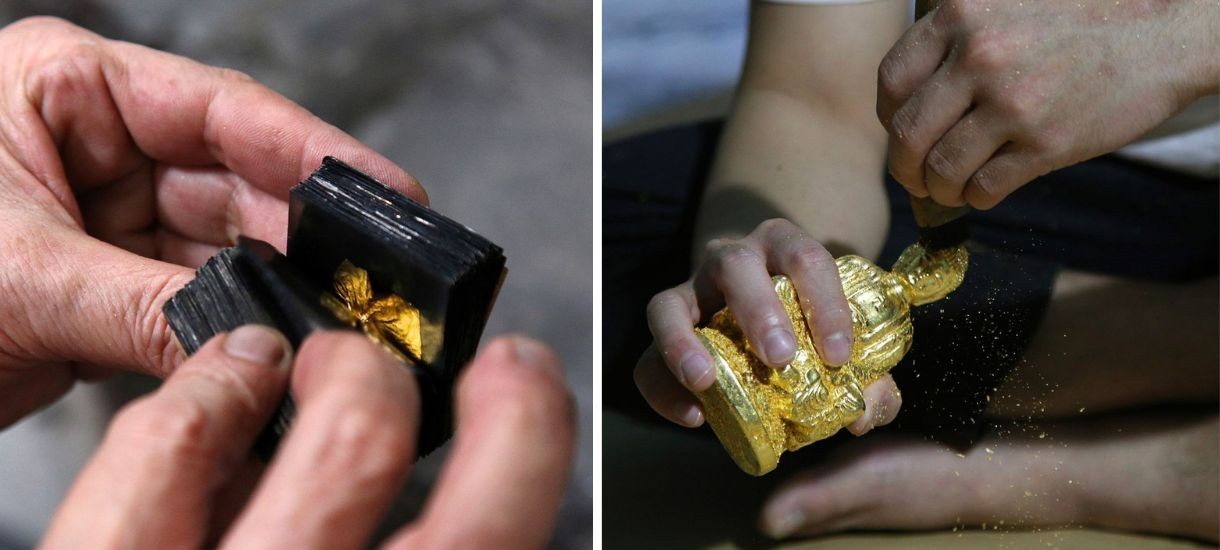 Kieu Ky Gold Beating
Kieu Ky Gold Beating
11.1. What Are Gold Leaves Used For?
These leaves are used to gild Buddha statues, decorate religious objects, and create special colors in lacquer painting.
11.2. How Laborious Is the Process?
The process of making gold leaves is incredibly laborious, requiring about 1,400 strikes of a sledgehammer per day.
11.3. How Much Gold Leaf Can Be Produced?
From 50 grams of gold, a skilled artisan can produce approximately 20 square meters of gold leaf.
12. Dong Ho Painting: Traditional Woodblock Prints
Dong Ho, located 40 kilometers east of Hanoi, is famous for making traditional woodblock prints.
.jpg)
12.1. What Is the Significance of Dong Ho Paintings?
These paintings were once a common sight during Tet (Vietnamese New Year), used to decorate homes and wish for good fortune.
12.2. How Are the Paintings Made?
Village life, stories, and tales are carved into wooden printing blocks and stamped on Dó paper using natural colors.
12.3. What Other Crafts Are Found in Dong Ho?
Many families now make paper houses, cars, and money for the deceased, reflecting Vietnamese beliefs about the afterlife.
13. Chuong Conical Hat Village: Iconic Symbols
Chuong, situated 30 kilometers southwest of Hanoi, is a charming rural village known for making conical hats (Nón lá).
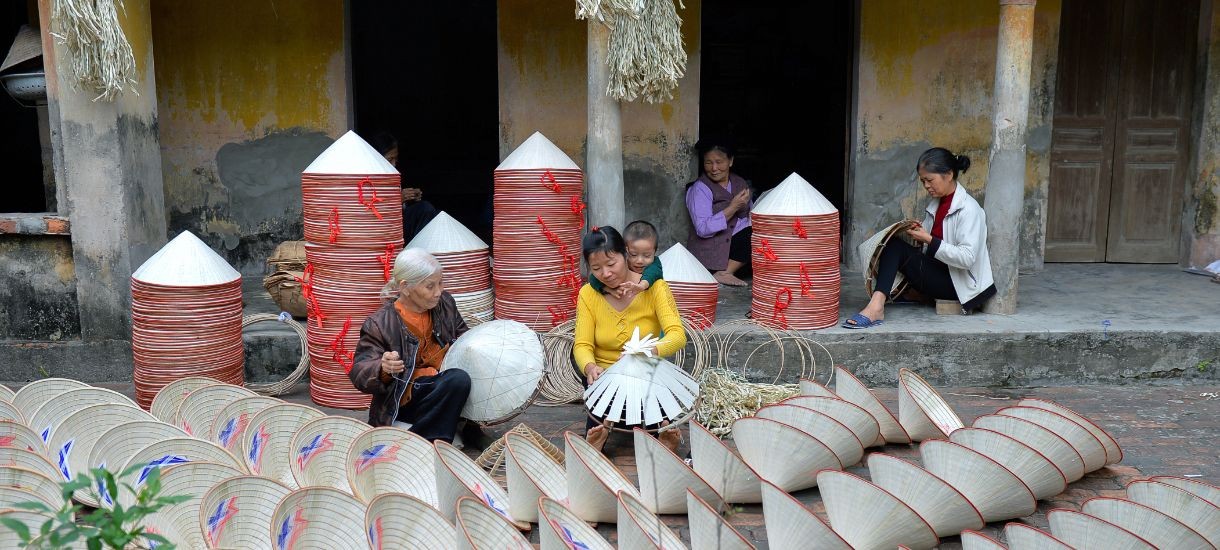 Chuong Conical Hat Village
Chuong Conical Hat Village
13.1. What Is the Significance of Conical Hats in Vietnam?
Conical hats, along with Áo dài (traditional dress), are iconic symbols of Vietnam, representing the charm of Vietnamese women.
13.2. How Are Conical Hats Made?
The hats are made from palm leaves stitched onto a conical frame with bamboo concentric circles.
13.3. When Is the Best Time to Visit Chuong Village?
The best time to visit is on the 4th, 10th, 14th, 20th, 24th, and 30th days of the lunar calendar when the village holds a large market.
14. Ha Thai Lacquer Village: Exquisite Artistry
Ha Thai, located south of Hanoi, is famed for the art of lacquer painting, which requires meticulous handiness, precaution, preparation, and patience.
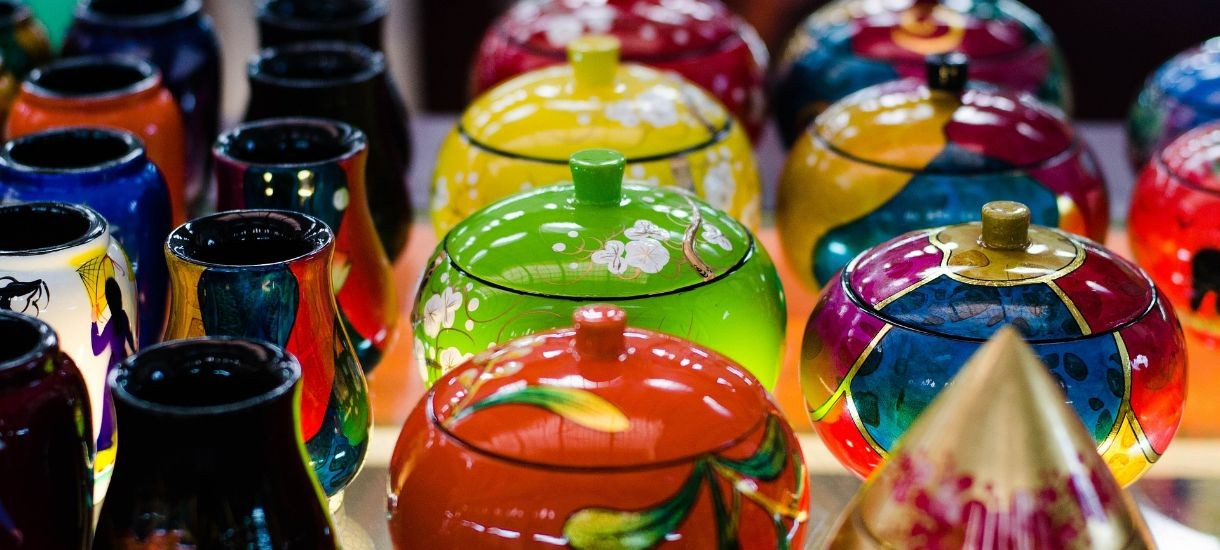 Ha Thai Lacquer Village
Ha Thai Lacquer Village
14.1. How Long Has Lacquer Been Made in Ha Thai?
Lacquer making has been a tradition in Ha Thai Village for over 200 years.
14.2. What Techniques Are Used in Lacquer Painting?
Artists experiment with layers of different colors, sanding and reworking each layer, and adding materials like gold leaf and eggshells.
14.3. What Products Are Made With Lacquer?
Bowls, flower vases, plates, and chopsticks are coated with lacquer and decorated beautifully.
15. Canh Hoach Bird Cage Making and Paper Fan Village: Dual Crafts
Canh Hoach is known for both bird cage making and paper fan production, offering a glimpse into diverse artistic traditions.
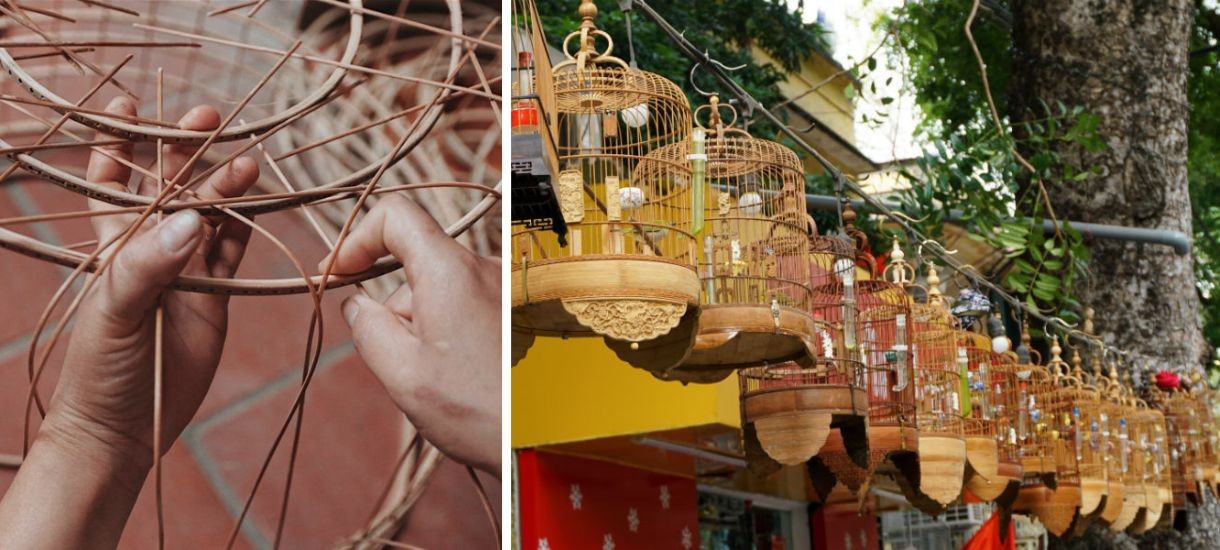 Canh Hoach Bird Cage Making and Paper Fan Village
Canh Hoach Bird Cage Making and Paper Fan Village
15.1. How Are Bird Cages Made?
Bamboo stems are immersed in water, split into thin strips, and assembled into bird cages of various shapes and sizes.
15.2. What Is Special About Canh Hoach Paper Fans?
The fans are made with purple paper and decorated with intricate designs punched by needles, visible under sunlight.
15.3. What Is the Significance of the Fan’s Slats?
The number of slats on the fan must be a multiple of four, with the possibility of one or two extra slats.
16. Essential Tips for Visiting Craft Villages in Hanoi
Planning a trip to Hanoi’s craft villages requires some preparation to ensure a smooth and enriching experience.
16.1. What Is the Best Time to Visit?
The best time to visit is during the dry season (October to April) for pleasant weather.
16.2. How Should I Dress?
Dress modestly and comfortably, especially when visiting religious sites.
16.3. What Should I Bring?
Bring sunscreen, a hat, comfortable shoes, and insect repellent.
17. Understanding Vietnamese Culture Through Craft Villages
Visiting craft villages provides a deeper understanding of Vietnamese culture, traditions, and way of life.
17.1. How Do These Villages Reflect Vietnamese History?
These villages have preserved ancient crafts that have been passed down through generations, reflecting the country’s rich history.
17.2. What Can I Learn About Vietnamese Values?
You can learn about the values of hard work, perseverance, and community that are integral to Vietnamese culture.
17.3. How Do These Crafts Contribute to Vietnamese Identity?
These crafts are an essential part of Vietnamese identity, representing the country’s artistic heritage and cultural pride.
18. Navigating the Language Barrier in Craft Villages
Communicating with local artisans can be challenging due to language differences, but there are ways to overcome this barrier.
18.1. Should I Learn Some Basic Vietnamese Phrases?
Learning basic phrases like “hello” (xin chào) and “thank you” (cảm ơn) can enhance your interactions.
18.2. Can SIXT.VN Provide a Translator?
SIXT.VN can provide a local guide who speaks both English and Vietnamese to facilitate communication.
18.3. Are There Translation Apps I Can Use?
Yes, translation apps like Google Translate can be helpful for basic communication.
19. Shopping for Pottery and Crafts: Tips and Etiquette
Shopping in craft villages can be a rewarding experience, but it’s important to follow certain guidelines and etiquette.
19.1. Is Bargaining Acceptable?
Bargaining is generally acceptable, but be respectful and offer a fair price.
19.2. How Can I Ensure I’m Buying Authentic Products?
Buy directly from the artisans to ensure the authenticity of the products.
19.3. What Payment Methods Are Accepted?
Cash is the most common form of payment, but some shops may accept credit cards.
20. Sustainable Tourism in Hanoi’s Craft Villages
Practicing sustainable tourism helps preserve the cultural heritage and environment of Hanoi’s craft villages.
20.1. How Can I Support Local Artisans?
Buy directly from the artisans and avoid purchasing mass-produced items.
20.2. How Can I Minimize My Environmental Impact?
Reduce waste, use reusable bags, and respect the natural environment.
20.3. How Can I Respect Local Customs?
Dress modestly, ask for permission before taking photos, and be mindful of local traditions.
21. Why Phu Lang Pottery Village Should Be on Your Bucket List
Phu Lang Pottery Village offers a unique and authentic travel experience that should be on every traveler’s bucket list.
21.1. What Makes Phu Lang Special?
Phu Lang offers a less touristy and more authentic experience compared to other pottery villages.
21.2. What Can I Experience There?
You can witness traditional pottery making, interact with local artisans, and learn about Vietnamese culture.
21.3. How Can SIXT.VN Help Me Plan My Trip?
SIXT.VN provides comprehensive travel services, including transportation, accommodation, and tours, to ensure a seamless and memorable experience.
22. Indulge in Vietnamese Cuisine Near Phu Lang
Exploring the culinary landscape near Phu Lang Pottery Village is a must for any traveler. Delight in the local flavors and traditional dishes that define Vietnamese cuisine.
22.1. What Are Some Local Dishes to Try?
Sample regional specialties such as bún chả (grilled pork with noodles), phở (noodle soup), and nem rán (spring rolls) for an authentic culinary experience.
22.2. Where Can I Find Authentic Vietnamese Food?
Visit local eateries and family-run restaurants in the surrounding areas to savor the true taste of Vietnamese cuisine.
22.3. Are There Any Food Tours Available?
SIXT.VN can arrange food tours that guide you through the best culinary spots, offering a delicious journey through local flavors.
23. Accommodation Options Near Phu Lang
Finding the right place to stay near Phu Lang Pottery Village is crucial for a comfortable and convenient visit. Consider various accommodation options to suit your preferences and budget.
23.1. What Types of Accommodations Are Available?
Choose from guesthouses, boutique hotels, and homestays that offer a range of amenities and experiences.
23.2. How Can SIXT.VN Help with Hotel Bookings?
SIXT.VN provides a seamless hotel booking service, offering a variety of options to match your needs and budget.
23.3. Should I Book in Advance?
Booking in advance is highly recommended, especially during peak tourist seasons, to ensure availability and secure the best rates.
24. Safety Tips for Travelers in Hanoi’s Craft Villages
Ensuring your safety while exploring Hanoi’s craft villages is paramount. Follow these safety tips to have a worry-free experience.
24.1. What Are Common Safety Concerns?
Be aware of petty theft, especially in crowded areas. Keep your belongings secure and stay vigilant.
24.2. How Can I Protect My Belongings?
Use a secure bag, avoid displaying valuable items, and be cautious of your surroundings.
24.3. What Emergency Contacts Should I Have?
Keep a list of emergency contacts, including the local police and your embassy, readily available.
25. Capturing Memories: Photography in Phu Lang
Phu Lang Pottery Village offers countless opportunities to capture stunning photographs. Here are some tips for making the most of your photography experience.
25.1. What Are the Best Photo Spots?
Explore the village’s clay-brick houses, traditional kilns, and pottery workshops for unique photo opportunities.
25.2. Should I Ask for Permission Before Taking Photos?
Yes, always ask for permission before photographing local artisans and residents to respect their privacy.
25.3. What Equipment Should I Bring?
Bring a versatile camera, extra batteries, and a wide-angle lens to capture the essence of the village.
26. Events and Festivals Near Phu Lang Pottery Village
Participating in local events and festivals near Phu Lang Pottery Village can enrich your cultural experience.
26.1. Are There Any Local Festivals?
Check for local festivals and events that may be taking place during your visit to immerse yourself in the local culture.
26.2. How Can I Find Information About Events?
Consult local tourism websites and community boards for information on upcoming events and festivals.
26.3. What Cultural Experiences Can I Expect?
Experience traditional music, dance, and rituals that showcase the vibrant cultural heritage of the region.
27. Transportation Options to and from Phu Lang
Understanding your transportation options to and from Phu Lang is essential for a smooth and efficient trip.
27.1. What Are the Main Modes of Transport?
Choose from private car services, taxis, and buses to reach Phu Lang from Hanoi.
27.2. How Can SIXT.VN Assist with Transportation?
SIXT.VN offers reliable and comfortable transportation services, including private car rentals and airport transfers.
27.3. Should I Arrange Transportation in Advance?
Arranging transportation in advance is advisable to ensure a hassle-free journey, especially during peak travel times.
28. Interacting Respectfully with Local Communities
Engaging respectfully with local communities enhances your travel experience and supports sustainable tourism.
28.1. How Can I Show Respect?
Learn basic Vietnamese phrases, dress modestly, and be mindful of local customs and traditions.
28.2. Should I Participate in Local Activities?
Participating in local activities, such as pottery workshops, can deepen your cultural understanding.
28.3. How Can I Support Local Businesses?
Support local businesses by purchasing crafts directly from artisans and dining at family-run restaurants.
29. Exploring Phu Lang with Children: Family-Friendly Activities
Phu Lang Pottery Village offers family-friendly activities that cater to travelers of all ages.
29.1. Are There Activities Suitable for Children?
Engage in pottery making workshops, explore the village’s scenic landscapes, and interact with local artisans.
29.2. What Should I Bring for My Children?
Bring comfortable shoes, sunscreen, hats, and insect repellent to protect your children from the elements.
29.3. Are There Family-Friendly Accommodations?
Look for guesthouses and homestays that offer family-friendly amenities, such as spacious rooms and play areas.
30. The Future of Pottery in Phu Lang
The future of pottery in Phu Lang hinges on preserving traditional techniques while adapting to modern demands.
30.1. How Are Artisans Adapting to Modern Times?
Artisans are exploring new designs and marketing strategies to appeal to a wider audience.
30.2. What Challenges Do They Face?
Challenges include competition from mass-produced items and the need to attract younger generations to continue the craft.
30.3. How Can Tourists Help Preserve This Tradition?
Tourists can help by purchasing authentic products, supporting local artisans, and spreading awareness about Phu Lang’s unique heritage.
31. Unveiling the Mystique of Vietnamese Craftsmanship
Vietnamese craftsmanship is a testament to the country’s rich cultural heritage and artistic traditions.
31.1. What Makes Vietnamese Crafts Unique?
Vietnamese crafts blend traditional techniques with unique cultural motifs, resulting in distinctive and artistic products.
31.2. How Can I Appreciate the Artistry?
Take time to observe the intricate details, learn about the history behind each craft, and interact with the artisans.
31.3. Are There Craft Museums to Visit?
Visit craft museums in Hanoi to gain a deeper appreciation for the country’s artistic heritage.
32. Tailoring Your Trip to Phu Lang with SIXT.VN
Customizing your trip to Phu Lang Pottery Village with SIXT.VN ensures a personalized and memorable experience.
32.1. How Can SIXT.VN Tailor My Trip?
SIXT.VN offers customized itineraries, transportation options, and accommodation choices to suit your preferences.
32.2. Can I Add Specific Activities?
Yes, you can add specific activities, such as pottery workshops, culinary tours, and cultural excursions, to your itinerary.
32.3. How Do I Get Started?
Contact SIXT.VN to discuss your travel plans and create a tailored itinerary that meets your needs and interests.
33. Alternative Craft Villages to Explore Near Hanoi
While Phu Lang is a gem, there are other craft villages near Hanoi worth exploring, each offering unique experiences.
33.1. What Other Villages Should I Consider?
Explore Bat Trang for ceramics, Dong Ho for woodblock prints, and Van Phuc for silk weaving.
33.2. How Do These Villages Differ?
Each village specializes in a unique craft, using different techniques and materials to create distinct products.
33.3. Can I Visit Multiple Villages in One Trip?
Yes, SIXT.VN can arrange multi-village tours, allowing you to experience the diversity of Hanoi’s craft traditions.
34. Must-Have Souvenirs from Hanoi’s Craft Villages
Collecting souvenirs from Hanoi’s craft villages is a great way to remember your trip and support local artisans.
34.1. What Are Some Popular Souvenirs?
Consider purchasing pottery from Phu Lang, silk from Van Phuc, woodblock prints from Dong Ho, and conical hats from Chuong.
34.2. How Can I Ensure Quality?
Buy directly from artisans, inspect the products carefully, and ask about the materials and techniques used.
34.3. Are There Any Packing Tips?
Pack delicate items carefully, using bubble wrap and protective containers to prevent damage during transit.
35. Making the Most of Your Cultural Immersion
Immerse yourself in the local culture to gain a deeper understanding and appreciation of Hanoi’s craft villages.
35.1. How Can I Fully Immerse Myself?
Participate in local activities, attend cultural events, learn basic Vietnamese phrases, and engage with the community.
35.2. Are There Volunteer Opportunities?
Explore volunteer opportunities to contribute to the preservation of local crafts and support community development.
35.3. How Can I Stay Connected to the Culture After My Trip?
Stay connected by following local artisans and cultural organizations on social media, purchasing their products online, and sharing your experiences with others.
36. Practical Information for Traveling to Hanoi
Knowing some practical information can make your trip to Hanoi smoother and more enjoyable.
36.1. What Is the Local Currency?
The local currency is the Vietnamese Dong (VND).
36.2. Do I Need a Visa?
Check visa requirements based on your nationality before traveling.
36.3. What Is the Weather Like?
Hanoi has a humid subtropical climate, with hot, humid summers and mild, dry winters.
37. Frequently Asked Questions About Buying Pottery in Phu Lang
Here are some frequently asked questions to help you plan your visit to Phu Lang Pottery Village.
37.1. Is it easy to get to Phu Lang from Hanoi?
Yes, it is easily accessible by car or bus, and SIXT.VN offers transportation services.
37.2. Can I see the pottery-making process?
Yes, you can visit workshops and observe artisans at work.
37.3. Are there any specific times to visit?
Visiting during the weekdays is ideal to avoid weekend crowds.
37.4. What is the price range for pottery?
Prices vary depending on the item, but bargaining is acceptable.
37.5. Can I ship pottery items home?
Yes, some shops offer shipping services, or SIXT.VN can assist with logistics.
37.6. Are there any tours available to Phu Lang?
Yes, SIXT.VN offers guided tours to Phu Lang.
37.7. Is it necessary to speak Vietnamese?
English is spoken in some shops, but having a translator can be helpful.
37.8. Can I customize my own pottery?
Some workshops may offer customization options.
37.9. Is it safe to travel to Phu Lang?
Yes, Phu Lang is generally safe for tourists.
37.10. What other attractions are nearby?
Explore nearby temples and scenic landscapes.
Visiting Phu Lang Pottery Village is more than just a trip; it’s an immersive cultural experience. With SIXT.VN, you can ensure a seamless and enriching journey, creating memories that will last a lifetime. From transportation and accommodation to customized tours and local insights, SIXT.VN is your trusted partner for exploring the beauty and traditions of Vietnam.
Ready to explore Phu Lang and experience the magic of Vietnamese pottery firsthand? Contact SIXT.VN today to start planning your unforgettable adventure.
Address: 260 Cau Giay, Hanoi, Vietnam
Hotline/Whatsapp: +84 986 244 358
Website: SIXT.VN



